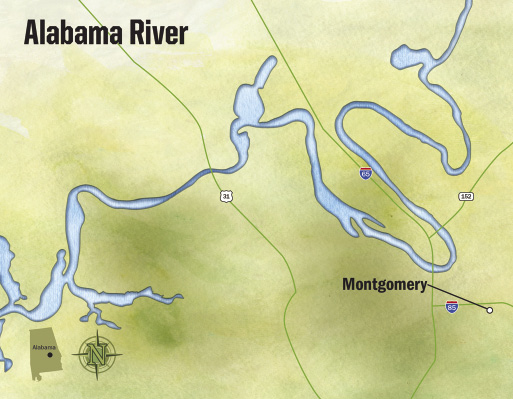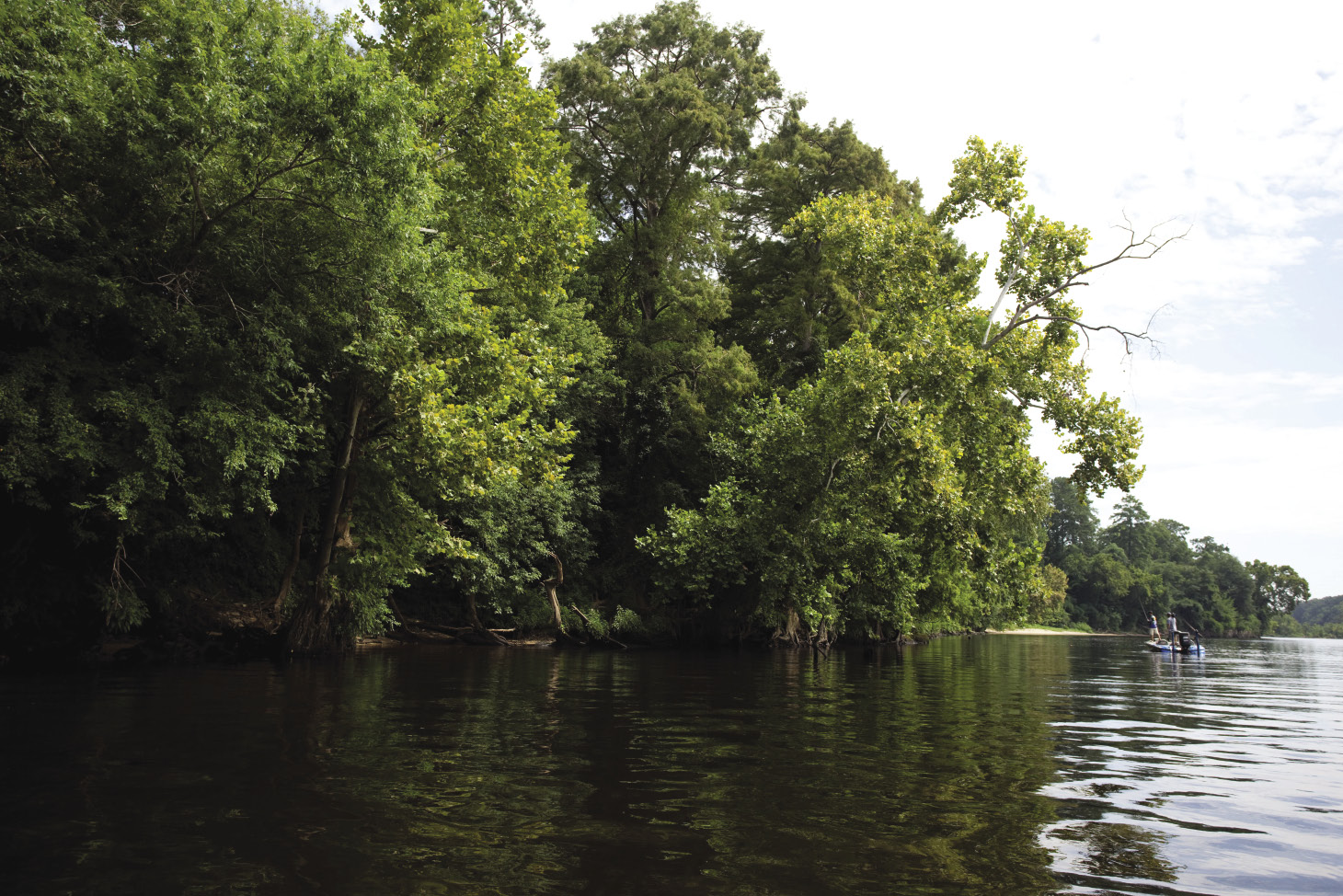
If you like fishing for shallow bass, the Alabama River is the place to be in July and August, says Bassmaster Elite Series pro Russ Lane. He lives only 3 miles from the Cooter’s Pond boat ramp in the Jones Bluff (R. E. “Bob” Woodruff Reservoir) stretch of the Alabama River.
“The Alabama River usually has a nice stained color to it,” Lane points out. “That’s one reason the bass stay shallow here in the summertime.”
The Coosa and Tallapoosa rivers give birth to the Alabama River about 6 miles north of Montgomery. It meanders 318 miles southwest through Alabama to meet the Tombigbee River. The dams along this navigable river slow its flow and form three run-of-the-river reservoirs: Jones Bluff, Millers Ferry and Claiborne.
Most local anglers, including Lane, simply call Jones Bluff the Alabama River. This upper section grows huge spotted bass that hang in current breaks on the main river. The largemouth grow fat in quiet sloughs and flooded creeks.
 Millers Ferry, the next reservoir downstream, is officially the William “Bill” Dannelly Reservoir. This 105-mile reach of the Alabama River boasts excellent largemouth fishing and is also widely known for its abundant crappie.
Millers Ferry, the next reservoir downstream, is officially the William “Bill” Dannelly Reservoir. This 105-mile reach of the Alabama River boasts excellent largemouth fishing and is also widely known for its abundant crappie.
Downstream from Millers Ferry is 60-mile-long Claiborne Lake, which remains mostly within its original riverbanks. It offers good fishing for largemouth bass and crappie.
The 72.5-mile reach of the lower Alabama River is one of the state’s natural wonders. Here you can cast for largemouth and spotted bass while taking in scenic high bluffs.
TOPWATER SPOTTED BASS
When Lane launches his boat at Cooter’s Pond before daybreak, he sets out in search of the Alabama River’s feisty spotted bass. Key places for a morning feeding spree are the mouths of sloughs and pockets, bluff points and windfalls that break the main river’s current.
Later in the morning, Lane often finds spotted bass chasing baitfish on shallow sandbars.
“There are a lot of 3-pound spotted bass here,” Lane says. “They really go for topwater baits on summer mornings.”
A Buckeye Lures buzzbait with a translucent shad color skirt puts Lane in touch with eager spotted bass. He dresses the hook with a slender 3 1/2-inch disco violet Cane Thumper paddletail minnow from Big Bite Baits.
“I like a 1/4-ounce buzzbait in calm water and a 1/2-ounce size when a breeze chops the surface” Lane says. “I fish buzzbaits on a 7-foot medium-heavy baitcasting rod with Sunline FX2 50-pound braid.”
WAKE ’EM UP
 Lane’s other spotted bass smasher is an oyster color Wake Up Wake Bait, also from Buckeye Lures. This buoyant, balsa long minnow lure floats high and wobbles across the surface when retrieved slowly, creating a V wake.
Lane’s other spotted bass smasher is an oyster color Wake Up Wake Bait, also from Buckeye Lures. This buoyant, balsa long minnow lure floats high and wobbles across the surface when retrieved slowly, creating a V wake.
“You need to hold the rod high to keep that bait from diving under the surface,” Lane adds.
He relies on a 7-foot, 6-inch medium action Castaway Skeleton Cranking Rod and 12-pound fluorocarbon to keep the Wake Up working on the surface. Lane concentrates on the middle section of Jones Bluff when casting for spotted bass.
LARGEMOUTH AT HIGH NOON
When the sun gets high and kills the topwater bite, Lane switches gears and heads for shallow creeks where largemouth bass lurk. Calawasse Creek, Pintlala Creek and the Crescent Lake area are high on his hit list.
“The water temperature can be in the low 90s late in the day,” Lane says. “What will surprise a lot of people is that the largemouth go shallow when the water gets hot. The shad get shallow, too.”
Lane suspects that a slow summertime current and a lack of oxygen draws the bass into the shallows. Whatever the reason, he knows how to take full advantage of this opportunity.
With two flippin’ rods matched with 25-pound fluorocarbon, Lane attacks outside creek bends in the backwaters. The water is deeper there and offers more cover in the form of laydowns, stumps and brushpiles.
One flippin’ rod is paired with a 3/8-ounce bullet sinker and a 4-inch Big Bite Yomama beaver-style bait with wide pincers. The other rod is rigged with a 5/16-ounce sinker and a 4.75-inch deeply ribbed Big Bite Coontail Worm.
“The flippin’ bite can be slow, but you’ll catch 12 to 15 bass by the end of the day,” Lane says. “There’s a good chance you’ll have a few that’ll go 4 pounds and maybe one heavier than 5.
GO HERE FIRST
Before you visit the Alabama River or any other Alabama reservoir, go to alabamabasstrail.org. Here you’ll find detailed information about nine lakes and two major river systems on the Alabama Bass Trail, including fishing locations, productive fishing patterns, local guides, campgrounds and where to stay.




